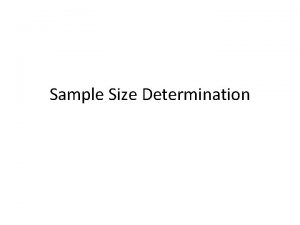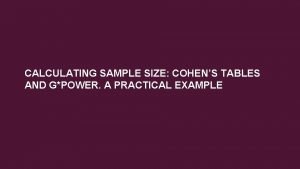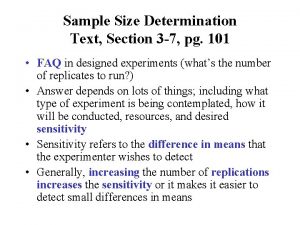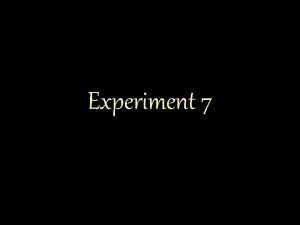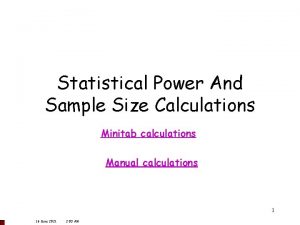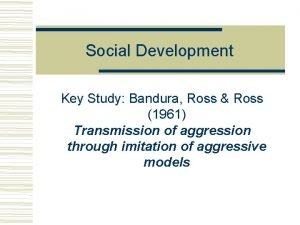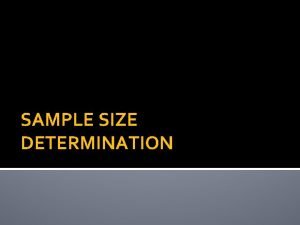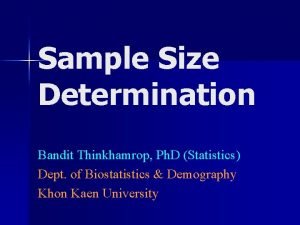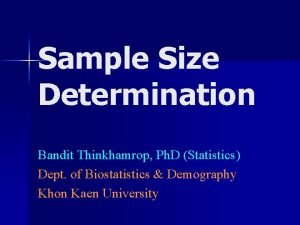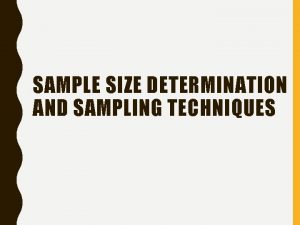Sample Size Determination Text Section 3 7 pg















- Slides: 15

Sample Size Determination Text, Section 3 -7, pg. 101 • FAQ in designed experiments (what’s the number of replicates to run? ) • Answer depends on lots of things; including what type of experiment is being contemplated, how it will be conducted, resources, and desired sensitivity • Sensitivity refers to the difference in means that the experimenter wishes to detect • Generally, increasing the number of replications increases the sensitivity or it makes it easier to detect small differences in means

• Choice of sample size is closely related to the probability of type II error b. • Hypotheses H o: m 1 = m 2 H 1: m 1 m 2 • Type I error – reject H 0 when it is true (a) • Type II error – fail to reject H 0 when it is false (b) • Power = 1 – b = P(Reject Ho Ho is false) = P(Fo > Fa, a-1, N-a Ho is false) • The probability of type II error depends on the true difference in means d = m 1 - m 2

Operating Characteristic Curves for Fixed Effects/Equal Sample Sizes per Treatment Case § Operating characteristic curves plot b against a parameter F where § F is related to d. It depends on a (0. 01 and 0. 05) and degrees of freedom for numerator (a-1) and denominator (N-a). § Assumptions and trials are needed to use the curves

§ s 2 can be estimated through prior experience/ previous experiment/preliminary test/judgment, or assuming a range of likely values of s 2. • ith treatment effect where Assumed mi’s can be used for which we would like to reject the null hypothesis with high probability § Example (etch rate experiment) If the experimenter is interested in rejecting the null hypothesis with a probability of at least 0. 90 if the five treatment means are m 1 = 575 m 2 = 600 m 3 = 650 m 4 = 675

§ a = 0. 01 is planned § a = 4, N = an = 4 n, a – 1 = 3, N – a = 4(n-1) § is calculated using assumed mi’s § s is assumed no larger than 25 § § Find the right plot: § a – 1 = 3 (= v 1) determines the use of the upper plot on page 614 (Appendix Chart V) § Because a = 0. 01 the curves on the right side are used

Chart V. Operating characteristic curves for the fixed effects model analysis of variance (Page 614) the upper graph with v 1=3 should be used.

§ The objective is to find a b to see if the power is satisfied § It needs v 2 (or n) to determine the particular curve, and a value of F to determine b 2. 74 a(n-1) 8 0. 25 Power (1 - b) 0. 75 10. 0 3. 16 12 0. 04 0. 96 12. 5 3. 54 16 <0. 01 >0. 99 n 3 F 2 F 7. 5 4 5 § Therefore, at least n = 4 b

• It is often difficult to select a set of treatment means for choosing the sample size • A very common way to use these charts is to define a difference in two means D of interest, then the minimum value of F 2 is • Typically work in term of the ratio of D/s and try values of n until the desired power is achieved

Other Methods of Determining Sample Sizes Specifying a Standard Deviation Increase • As the difference between means increase, the standard deviation increases • Choose a percentage P for the increase in s of an observation beyond which the null hypothesis is rejected, equivalently

Specifying a Standard Deviation Increase (continued) • Rearrange it, • Therefore, F can be expressed as • Specify P, a, and the probability to reject the null hypothesis, then determine n.

Confidence Interval Estimation Method • Specify in advance how wide the confidence intervals should be by specifying the accuracy of the confidence interval • No OC curves are needed. Example: the etch rate experiment. • Need a and N (an) to determine ta/2, N-a, and s to estimate MSE • Specify the level of confidence (95%, or a =0. 05), difference in mean to be determined (30Å/min), and (prior) estimate s 2 (252 =625)

Confidence Interval Estimation Method (continued) • Procedure: compare the accuracy with an assumed n, with the specified accuracy (30Å/min) • When n = 5, ta/2, N-a =2. 120, • When n = 6, ta/2, N-a =2. 086, • When n = 7, ta/2, N-a =2. 064,

Dispersion Effects • Focus is location effects so far using ANOVA: factor level means and their differences • It needs constant variances. If not, using transformations to stabilize the variances. • Sometime the dispersion effects are of interest: whether the different factor levels affect variability • In such analysis, standard deviation, variance, or other measures of variability are used as response variables

An Example – Al Smelting Experiment • A reaction cell: Alumina and other ingredients (with a certain ratio) under electric resistance heating • Four different ratio control algorithms • Cell voltage is recorded (thousands of voltage measurements during each run) • A run consists of one ratio control algorithm • Average cell voltage (affecting cell temperature), and the standard deviation of cell voltage over a run (affecting overall cell efficiency) are response variables

Ratio Control Algorithm 1 2 3 4 5 6 1 4. 93(0. 05) 4. 86(0. 04) 4. 75(0. 05) 4. 95(0. 06) 4. 79(0. 03) 4. 88(0. 05) 2 4. 85(0. 04) 4. 91(0. 02) 4. 79(0. 03) 4. 85(0. 05) 4. 75(0. 03) 4. 85(0. 02) 3 4. 83(0. 09) 4. 88(0. 13) 4. 90(0. 11) 4. 75(0. 15) 4. 82(0. 08) 4. 90(0. 12) 4 4. 89(0. 03) 4. 77(0. 04) 4. 94(0. 05) 4. 86(0. 05) 4. 79(0. 03) 4. 76(0. 02) Observations • An ANOVA determines that the ratio control algorithm had no location effects (the ratio control algorithm does not change the average cell voltage) • A transformation is used to study the dispersion effects y = -ln(s) • A standard ANOVA can be done on y, the natural logarithm of standard deviation -> algorithm 3 produces different standard deviation than others
 Sample size calculation example
Sample size calculation example Gpower sample size calculator
Gpower sample size calculator Sample size determination
Sample size determination Text to text text to self text to world
Text to text text to self text to world Gravimetric principle
Gravimetric principle Const char *s =
Const char *s = Name any two mechanism of size separation
Name any two mechanism of size separation Research instrument example
Research instrument example Power analysis minitab
Power analysis minitab Bandura ross and ross
Bandura ross and ross What is the sample size in qualitative research?
What is the sample size in qualitative research? What is the sample size in qualitative research?
What is the sample size in qualitative research? Factors affecting sample size
Factors affecting sample size How to calculate sample size in research
How to calculate sample size in research Sample size formula
Sample size formula Krejcie and morgan formula
Krejcie and morgan formula
